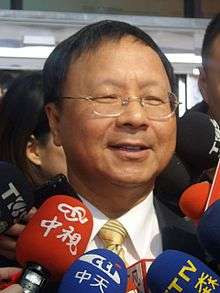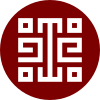Tu Cheng-sheng
Tu Cheng-sheng (born 10 June 1944) is a Taiwanese politician and historian. Tu served as the Minister of Education of the Republic of China during Chen Shui-bian's second term as President.[1]
Tu Cheng-sheng | |
|---|---|
杜正勝 | |
 Minister Tu in 2007 | |
| 22nd Minister of Education of the Republic of China | |
| In office 20 May 2004 – 20 May 2008 | |
| Director of National Palace Museum | |
| In office 20 May 2000 – 20 May 2004 | |
| Personal details | |
| Born | June 10, 1944 Mida Village, Okayama District, Takao Prefecture, Japanese Taiwan (vic. modern-day Mituo District, Kaohsiung, Taiwan) |
| Nationality | Republic of China |
| Political party | Democratic Progressive Party |
| Alma mater | National University of Tainan National Taiwan University |
| Occupation | Politician |
| Profession | Historian |
| Tu Cheng-sheng | |||||||||||
|---|---|---|---|---|---|---|---|---|---|---|---|
| Traditional Chinese | 杜正勝 | ||||||||||
| Simplified Chinese | 杜正胜 | ||||||||||
| |||||||||||
Education and career
Tu Cheng-sheng graduated from the Provincial Tainan Normal University (present-day National University of Tainan) in 1966. He also attended the National Taiwan University in 1970 and majored in history (bachelor's degree 1970, master's degree 1974). He is a specialist in the history of ancient Chinese society, culture and medicine.
In articles of 1986, 1987 and 1992 Tu explored semblance between the city-states of the ancients Western civilization and the state formations of early China.[2]
He served as Director of National Palace Museum from May 2000 to May 2004.[3] He also served as a director of a research center on history and languages of the Academia Sinica and a professor at the National Tsing Hua University.
Personality
Tu gained notoriety for his colorful and abrasive behavior. After being filmed asleep at a 2007 meeting of the Legislative Yuan, he was photographed picking his nose in response to public criticism. Also that year, he grabbed a reporter's microphone and shoved a cameraman into a wall.[1]
Publications
- 走過關鍵十年 / 1990-2000 [Going Through the Ten Critical Years: 1990-2000] (in Chinese). 2000. ISBN 957-469-141-1.
- 臺灣的誕生 : 十七世紀的福爾摩沙 [The Birth of Taiwan: Formosa in the 17th Century] (in Chinese). 2003. ISBN 957-28159-1-1., translation: Ilha Formosa: the Emergence of Taiwan on the World Scene in the 17th Century
- 新史學之路 [New Road for Historical Studies] (in Chinese). 2004. ISBN 957-14-4027-2.
- 臺灣的教育改革與臺灣的未來 [Educational Reform in Taiwan: Retrospect and Prospect] (in Chinese). 2007. OCLC 173372350.
References
- "Nose-picking lawmaker to shout his last good-bye", Reuters, Apr 24, 2008
- Yates, Robin D.S. "The City-State in Ancient China"
- Museum, National Palace (2020-05-08). "Present/Former Leaders". National Palace Museum. Retrieved 2020-06-27.
| Government offices | ||
|---|---|---|
| Preceded by Chin Hsiao-yi |
Director of National Palace Museum 2000–2004 |
Succeeded by Shih Shou-chien |
| Preceded by Huang Jong-tsun |
ROC Minister of Education 2004–2008 |
Succeeded by Cheng Jei-cheng |
| Wikimedia Commons has media related to Tu Cheng-sheng. |
